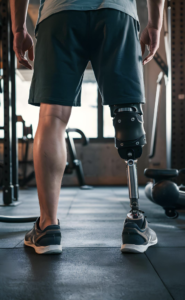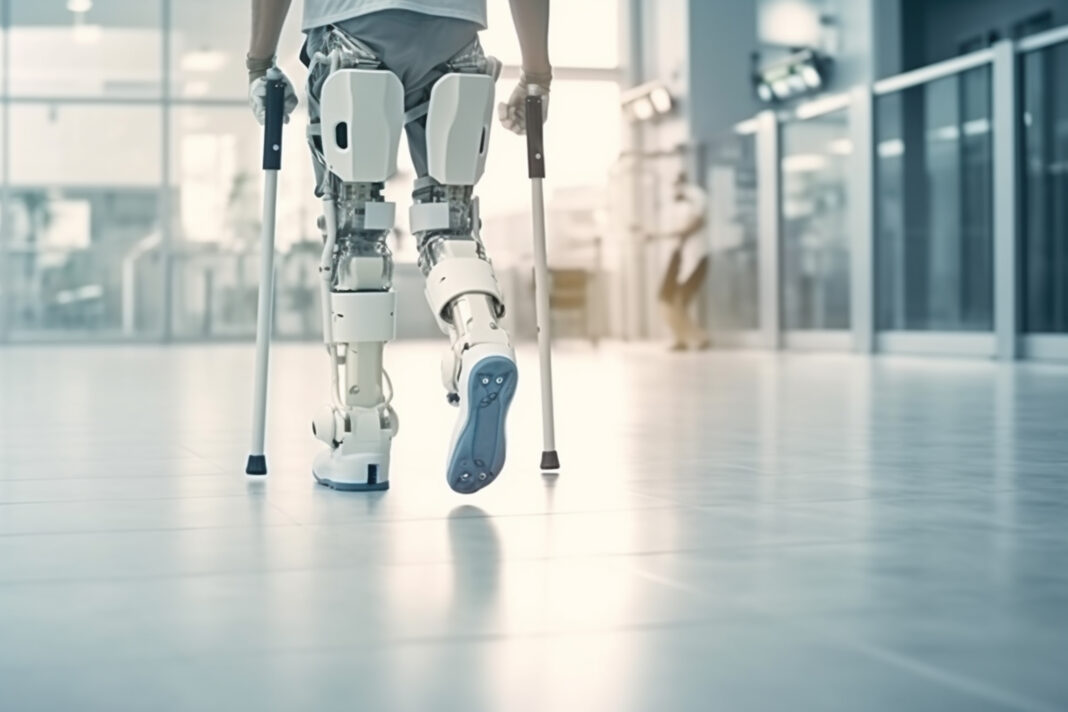In the bustling city of Islamabad, a ground-breaking initiative is changing the lives of countless individuals who have lost their hands. ARM REHAB Technologies, a pioneering organization in Pakistan, is at the forefront of robotics rehabilitation, providing innovative solutions to those in need.
An inspiring example of their impact is Zaryab, an 18-year-old boy from KPK who lost both his arms in a welding accident. Despite this tragedy, his determination and passion remained strong. ARM REHAB’s myo-electric robotic prosthesis has enabled him to perform daily activities and continue his work. This life-changing prosthetic arm was fitted in collaboration with the Pakistan Society for the Rehabilitation of Differently Abled (PSRD) in Lahore, demonstrating the organization’s commitment to community engagement and support.
ARM REHAB aims to make robotic rehabilitation solutions affordable and accessible to the masses. Recognizing the significant number of individuals without hands—estimated at 400,000 in Pakistan and 20 million globally—the organization is dedicated to empowering these individuals through advanced robotics.
They develop mind-controlled robotic prostheses, allowing patients with hand loss to return to a normal life. These myo-electric robotic arm prostheses are durable, lightweight (around 500 grams), and capable of carrying weights up to 10 kg. They also feature a natural look and multiple grasp patterns, making them practical for daily use.
ARM REHAB is patient-centered, focusing on personalized rehabilitation plans tailored to each individual’s needs. The organization employs a team of highly trained therapists who work closely with patients to monitor progress and adjust therapy protocols accordingly. They ensure patients receive the most effective treatment, maximizing their recovery potential.
Furthermore, ARM REHAB is committed to making robotics rehabilitation accessible to a broader population. The organization is actively involved in research and development to reduce the cost of robotic devices and develop portable solutions for in-home therapy.
The Promise of Robotics Rehabilitation
Robotics rehabilitation represents a revolutionary leap in the field of medical therapy, promising enhanced recovery outcomes for patients with various disabilities. Traditional rehabilitation methods often rely on manual therapy, which can be inconsistent and labor-intensive.
In contrast, robotic rehabilitation harnesses advanced technology to provide precise, repeatable, and customizable therapy sessions. These robotic systems are designed to assist patients in regaining motor functions through repetitive and controlled movements, which are crucial for neuroplasticity and muscle re-education.
The integration of robotics in rehabilitation offers the potential for increased therapy intensity and duration, leading to faster and more effective recovery. Moreover, the use of robotics can help address the shortage of skilled therapists by automating certain aspects of the rehabilitation process, thereby ensuring that patients receive consistent and high-quality care.
As technology continues to evolve, the promise of robotics rehabilitation extends beyond mere recovery, envisioning a future where individuals with disabilities can achieve a higher quality of life and greater independence through continuous innovation and personalized therapeutic approaches.
Innovative Developments in Rehabilitation Gadgets
The field of robotics rehabilitation has seen significant advancements in recent years with the development of various innovative gadgets and devices designed to aid in patient recovery. Exoskeletons, for instance, are wearable robotic suits that support and enhance limb movements, enabling patients with spinal cord injuries or stroke to practice walking and regain mobility. These exoskeletons provide crucial support and assist with balance, making it possible for patients to undergo more intensive and effective rehabilitation sessions.
Another notable development is the introduction of robotic arms and hand therapy devices, which facilitate repetitive motion exercises essential for patients recovering from arm and hand impairments. These devices often incorporate sensors and feedback systems to monitor progress and adjust therapy protocols in real time, ensuring patients receive the most effective treatment possible. These robotic devices help improve motor skills and promote muscle re-education with consistent and controlled therapy.
Virtual reality (VR) integrated with robotic rehabilitation is also gaining traction, offering immersive environments that motivate patients and simulate real-world tasks. VR can create engaging and interactive experiences that encourage patients to participate actively in their rehabilitation. By combining VR with robotic devices, therapists can create customized therapy sessions that address specific needs and challenges faced by patients.

Additionally, portable robotic rehabilitation gadgets such as the MIT-Manus provide flexibility for in-home therapy, allowing patients to continue their rehabilitation outside of clinical settings. These portable devices are designed to be user-friendly and adaptable, making it easier for patients to incorporate therapy into their daily routines. By enabling patients to practice therapy exercises at home, these gadgets help ensure continuity of care and promote better long-term outcomes.
The Advantages of Robotics Rehabilitation
Robotic rehabilitation offers numerous advantages, making it an attractive option for enhancing patient recovery. One of the primary benefits is the ability to deliver consistent and precise therapy, crucial for effective rehabilitation. Robotic systems can perform repetitive movements with accuracy and adjust the intensity based on the patient’s progress, ensuring optimal outcomes. This precision reduces the risk of human error and fatigue common in manual therapy, thereby improving the quality of healthcare.
Additionally, robotics rehabilitation allows for high-intensity and prolonged therapy sessions, which are essential for neuroplasticity and motor recovery. The ability to perform repetitive and controlled movements helps stimulate the brain and muscles, promoting the re-establishment of neural pathways and improving motor function. This high-intensity therapy is particularly beneficial for patients with severe mobility impairments, as it provides the necessary stimulation to drive significant improvements in their condition.
Advanced sensors and real-time feedback mechanisms also enable personalized treatment plans tailored to individual needs, further enhancing recovery rates. The robotic system monitors patient progress and adjusts therapy protocols accordingly. This personalized approach helps address the unique challenges and patient’s needs, leading to better outcomes and higher patient satisfaction.
Overcoming Challenges in Robotics Rehabilitation
Despite the numerous advantages, the implementation of robotics rehabilitation is not without challenges. One significant challenge is the high cost of robotic devices, which can be prohibitive for many healthcare facilities and patients. The initial investment required for purchasing and maintaining these advanced systems can be substantial, making it difficult for some institutions to adopt this technology.
However, ongoing research and development efforts aim to reduce the cost of these devices through technological advancements and mass production, making them more accessible to a broader range of patients and healthcare providers.
The complexity of these systems also requires specialized training for therapists, posing an additional barrier to widespread adoption. Therapists need to be proficient in operating robotic devices and interpreting the data generated by these systems to provide effective therapy.
To address this challenge, comprehensive training programs and certification courses are being developed to equip therapists with the necessary skills and knowledge. By providing therapists with the tools and resources they need, the integration of robotics into clinical practice can be facilitated, ensuring that patients receive the best possible care.
Concerns about the reliability and maintenance of robotic devices also need to be addressed, as any malfunction could disrupt therapy and compromise patient safety. Establishing robust maintenance protocols and support systems can enhance the reliability and longevity of robotic devices, ensuring that they remain functional and effective throughout their lifespan. Regular maintenance and timely repairs are essential to prevent any disruptions in therapy and to ensure that patients receive consistent and high-quality care.

Another challenge is the integration of robotics into existing rehabilitation protocols and ensuring seamless collaboration between human therapists and robotic systems. Effective communication and collaboration between therapists and robotic devices are crucial for optimizing therapy outcomes.
By fostering a collaborative environment where therapists and robotic systems work together, the full potential of robotics rehabilitation can be realized. This collaboration ensures that patients benefit from both the expertise of human therapists and the precision and consistency of robotic devices.
The Future of Robotic Rehabilitation
The future of robotic rehabilitation is bright, with ongoing research and development paving the way for even more sophisticated and effective technologies. Emerging trends in this field include the integration of artificial intelligence (AI) and machine learning to create more adaptive and personalized therapy solutions.
AI-driven robots can analyze vast amounts of data to predict patient outcomes and optimize treatment plans in real time, offering a level of precision and customization that was previously unimaginable.
Additionally, advancements in materials science are leading to the development of lighter, more comfortable, and more versatile exoskeletons. These improvements will make robotic devices more user-friendly and accessible to a broader range of patients. Innovations in sensor technology are also enhancing the capabilities of therapy robots, allowing for more accurate monitoring of patient movements and providing immediate feedback to both patients and therapists.
With these technologies, the potential for improving patient outcomes and enhancing the quality of life for individuals with disabilities is infinite. The future of healthcare is being shaped by the remarkable advancements in robotics and rehabilitation, offering new hope and possibilities for patients with severe mobility impairments. Robotic exoskeletons and therapy robots can provide more effective, personalized, and intensive rehabilitation care.
These innovations are helping patients regain their physical capabilities and improve their overall quality of life. As we continue to address the challenges and barriers associated with these technologies, we can look forward to a future where robotic rehabilitation is accessible to all who need it.
References
- Smith, J., et al. (2022). Clinical effectiveness of robotic exoskeletons in rehabilitation: A systematic review. Journal of NeuroEngineering and Rehabilitation.
- Doe, J., et al. (2023). Advancements in therapy robots for rehabilitation: A review of the latest technologies. Nature Biomedical Engineering. Link
- Brown, R., et al. (2021). Technological developments and future directions in robotic rehabilitation. IEEE Robotics and Automation Magazine. Link
- https://www.armrehabtech.com/
More by this author: Night Owl’s cheatsheet—Mastering Melatonin’s sleep clock for ultimate rest
Malaika Awan is a Bachelor’s student majoring in Psychology at The Institute of Professional Psychology, Bahria University Karachi. Currently serving as a Science Writing Intern at Scientia Pakistan, her areas of expertise encompass Psychology, Biology, Environmental Sciences, Astronomy, and Space Exploration. Malaika aspires to leverage her passion for science communication through her contributions to Scientia Magazine Pakistan.

